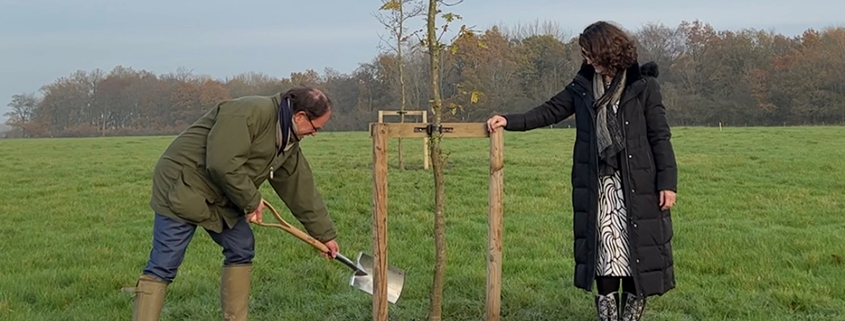A new woodland for Leeds
Last updated on 5 December 2022
A young oak was planted today to mark a new initiative to develop woodland on land owned by the University of Leeds.
Situated next to Golden Acre Park at Bramhope, the 37-hectare site – the size of 37 rugby pitches – will eventually be home to 66,000 new trees, a mixture of broadleaf species including oak, elder, hornbeam, wild cherry and silver birch.
Gair Wood has been developed as the result of a partnership between the Estates Team, Sustainability Service, United Bank of Carbon and the White Rose Forest and is named for Roger Gair who was University Secretary for more than 20 years and retired in 2021 and who put the first tree into the ground in a ceremony today (Friday 2 December.)
James Wright, Senior Maintenance Manager in the Facilities Directorate said:
“Mass planting of the woodland begins in the New Year with a team of professional landscapers and an opportunity for the public and volunteers from the University to get involved too.
“Gair Wood contributes to the target set by the White Rose Forest, the community forest for West and North Yorkshire by 2025, for 7 million more trees by 2025. It’s fantastic that the university is a part of this.”
Until the young trees have become well established, public access will be restricted, with increasing levels of access over the next five years as the saplings develop. The woodland will be connected by paths to the Leeds Country Way.
University’s Climate Plan
Developing Gair Wood is also part of the University’s Climate Plan through which the University is committed to net zero greenhouse gas emissions by 2030.
Dr Cat Scott, University Academic Fellow based in the School of Earth and Environment at Leeds and academic lead for Gair Wood, said:
“Creating this woodland will allow us to explore the impacts, in real-time, of tree planting as a nature-based solution to climate change. Researchers with a wide range of expertise are coming together to assess changes to diverse aspects of the site like the composition of the soil, the species of wildlife present, and local air quality as this new woodland evolves.”
The woodland will also connect existing habitats that have become fragmented, allowing wildlife to move to find food, mates and new locations to live. Students have already conducted baseline measurement of plants, insects, birds and mammals and these will be tracked to monitor how these change over the coming years.
The project is funded by the White Rose Forest through Defra’s Nature for Climate Fund with support from the Leeds City Council and the Forestry Commission.
Find out more about the University’s Sustainability Services.






